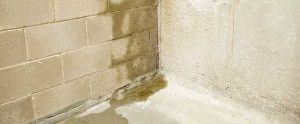Basement moisture is a very common issue; however, it is a problem that is not often understood and/or treated in the appropriate manner. If you have a basement that is rarely used and is separated from the living spaces within your home, you may believe that moisture in the basement is not an issue that needs to be contended with.
However, you would be mistaken. Moisture in this area of your home has the capable of damaging your home and negatively impacting your health. In this 2-part guide, you will learn why you may have an accumulation in your basement and will be presented with a few strategies that will help you effectively deal with the issue so that it does not harm your home or your health.
Why is There Moisture in the Basement?
The first step to appropriately correcting basement moisture is to determine exactly where the water is coming from. In most instances, there are only 3 different sources of water when it comes to your home’s basement. These are as follows:
- The water may be coming from rain or the ground water.
- There are certain types of moisture sources that may be causing the issue. These include – but are not limited to – clothes dryers that are not vented properly, humidifiers, moisture that is present within the concrete after the construction of the basement, bathrooms, and even moisture that stems from indoor cooking.
- If the outside air that surrounds the basement area is very humid, it could be that it enters into the basement. As it hits the cooler surfaces, it will start to condense, which results in moisture.
The Mechanisms of Moisture Transference to the Basement
When moisture is transferred from the outside of your home to the interior region of your basement, it is done so by 1 of 4 different mechanisms. Below, we will outline those mechanisms as well as a brief explanation of each:
- Liquid Flow of Water – This is the water that comes from the rain or the ground water. If your home does not have the proper grading, functional downspouts, and/or working gutters, the water may find its way into the basement. If there is a lot of seasonal rain and/or flooding, the water may come from a ride in the water table in the ground.
- Capillary Suction – This happens when the soil around the basement becomes heavily saturated. Then, the moisture will enter through porous materials and results in dampness.
- Water Diffusion – This is the movement of various levels of moisture in its vapor state through the foundation and walls of the basement.
- Air Leakage – As warm air rises in your home, an effect occurs that places pressure on the basement. This draws in moist air through any type of concrete cracks or openings, such as sump pumps and/or block cores.
To Learn More
In this 1st part of this series, we outlined that moisture in the basement can result in harm to both your health and your home. You also learned about where the water in your basement may be coming from and how moisture finds its way into your basement.
Join us in part 2 of this series to learn about the signs that moisture is present in your basement and some steps on how to resolve the issue. If you would like to cover your basement floor in order to protect it and your foundation from moisture damage, contact us here at Concrete Coatings today to learn more: 706-249-4131
